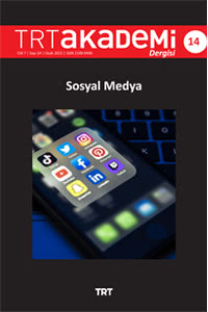“Büyük Yer Değiştirme” Terör Manifestosunda İslamofobi, Dini ve Etnik Nefret Söylemi
Yeni Zelanda’nın Christchurch kentindeki Al Noor Camisi ve Linwood İslam Merkezi’ne Brenton Tarrant adlı terörist, 15 Mart 2019 tarihli cuma namazı sırasında bir silahlı saldırı düzenlemişti. Bu araştırmada Tarrant’ın önceden hazırlayıp saldırıdan hemen önce de yayımladığı terör manifestosu Büyük Yer Değiştirme [The Great Replacement] başlıklı yetmiş dört sayfalık metni incelenmiştir. Bu araştırmada, şu araştırma sorularına cevap aranmıştır: Böylesine büyük bir saldırıyı yapmak üzere iki yıl süren bir suikast hazırlığının anatomisi nedir? Müslümanlara, Türkiye ve Türklere de terör manifestosunda yer veren bu şahsın amacı, motivasyonu ne olabilir? Bu sorulara cevap bulmak amacıyla araştırmada esas olarak frekans metin çözümlemesi yönteminden yararlanılmıştır. Avrupa kıtası başta olmak üzere pek çok gelişmiş ülkede Müslümanlara karşı her geçen gün saldırılar artmakta ve bu kronik soruna ivedilikle çözüm üretilmesi gerekmektedir. Bu araştırmada böyle bir olayın anatomisi incelenerek temel nedenlerini, giderek önemi artan bu tip olayları hazırlayan koşulları tespit edilerek aktif ve proaktif çözüm önerileri geliştirmek amaçlanmıştır. Araştırma anahtar kelimelerini oluşturan bu kronik sorunların çözümü için örgün eğitim sistemi ile birlikte başat informal öğrenme ortamı olan medya alanında özel çalışmaların yapılması gerektiği sonucuna ulaşılmıştır.
Anahtar Kelimeler:
Nefret Söylemi, İslamofobi, Türkofobi, Irkçılık, Avrupamerkezcilik
Islamophobia, Religious and Ethnic Hate Speech at “The Great Replacement” Terror Manifesto
The terrorist named Brenton Tarrant carried out an armed attack on the Al Noor Mosque and Linwood Islamic Center in Christchurch, New Zealand during Friday prayers on 15 March 2019. In this study, seventy-four-page terror manifesto titled The Great Replacement, which Tarrant prepared and published just before the attack was examined. This study attempts to answer the following research questions: What is the anatomy of an assassination preparation to such a big attack for two years; this person's purpose, motivation, what could it be? In order to find an answer to this question, frequency text analysis method is used in this study. As attacks against Muslims are increasing day by day in Europe, America and many developed countries, and this situation, which has become a chronic problem, needs to be solved urgently. In this study, it is aimed to develop active and proactive solution proposals by examining the anatomy of such an event and determining the main causes and conditions that prepared such increasingly important events. It has been concluded that special studies should be carried out in the field of media, which is the main informal learning environment, together with the formal education system, to solve these chronic problems meanwhile generate these keywords.
Keywords:
Hate Speech, Islamophobia, Turcophobia, Ethnocentrism, Eurocentrism,
___
- Benesch, S. (2014). Defining and diminishing hate speech. in: P. Grant (Hrsg.), State of the world’s minorities and indigenous peoples. 18-25.
- Breivik, A. B. (2011). 2083: A European Declaration of Independence. (Erişim tarihi: 07.06.2021), www.breiviksmanifesto.com
- Brooks, L. (2021, 13 Mayıs) Glasgow protesters rejoice as men freed after immigration van standoff. The Guardian. (Erişim tarihi: 20.06.2021), https://www.theguardian.com
- Chomsky, N. (2002). Terörizm kültürü. [The culture of terrorism]. İstanbul: Pınar Yayınları
- Chomsky, N. (2003). Amerikan müdahaleciliği. [Turning the tide: U.S. intervention in Central America and the struggle]. İstanbul: Aram Yayıncılık
- Dearden, L. (2019, 16 Mart) New Zealand attack: How nonsensical white genocide conspiracy theory cited by alleged gunman is spreading poison around the world. The Independent. (Erişim tarihi: 13.07.2021), https://www.independent.co.uk
- Davey, J., & Ebner, J. (2019). The Great Replacement’: The violent consequences of mainstreamed extremism. Institute for Strategic Dialogue, 7.
- Jenson, J., (2016, March 13). Invictus by William Ernest Henley. Poem Analysis. (Erişim tarihi: 11.07.2021), https://poemanalysis.com/william-ernest-henley/invictus/
- Kassin, S. M. (1998). Psychology (2nd. Ed.). New Jersey: Prentice Hall.
- Kara, E. Ş. (2017). Almanya’da Çocuklara Yönelik Yayınlanan Logo Kindernachrichten Haber Programının İçerik Analizi Yöntemiyle İncelenmesi. TRT Akademi, 2(4), 440-464.
- Lean, N.C. (2015). İslamofobi Endüstrisi. [The Islamophobia Industry How the Right Manufactures Fear of Muslims]. Ankara: Diyanet İşleri Başkanlığı Yayınları
- Malik, K., & Molnar, P. (2012). Interview with Kenan Malik. The Content and Context of Hate Speech. Cambridge University Press. Cambridge, 81-91
- McTeigue, J. (2005). V for Vendetta. United States: Warner Bros.
- Neshkovska, S., & Trajkova, Z. (2017). The essentials of hate speech. Teacher, 14(1), 71-80.
- Özsüer, E. (2018). Türkokratia - Avrupa’da Türk İmajı. İstanbul: Kronik.
- Popovic, S. (2007). CANVAS core curriculum: A guide to effective nonviolent struggle. Students Book. Belgrade: CANVAS - Centre for Applied Nonviolent Action and Strategies. (Erişimi tarihi: 05.07.2021), https://www.nonviolent-conflict.org/wpcontent/uploads/2016/04/CANVAS-CoreCurriculum_EN4.pdf
- Redbeard, R. (1999). Might is right: survival of the fittest(1910). London: Millenial Wotansvolk
- Sinclair, U. (2020). Şikago mezbahaları. [The Jungle]. İstanbul: Sel
- Spiridovitch, A.T. (2007). Türksüz Avrupa. (Çev. A. Ataman). İstanbul: Pınar
- Varol, F. B. (2020). İslamofobi söylemi Avrupa basınında yükselen bir trend. İstanbul:Pınar Young, S. W. & Caine, J. (2020). Hate speech and hate crime related legislation. Royal Commission Report Published 26 November 2020 (Erişimi tarihi: 18.05.2021), www.christchurchattack.royalcommission.nz Zizek, S. (2018). Şiddet. [Violence]. İstanbul: Encore
- ISSN: 2149-9446
- Yayın Aralığı: Yılda 3 Sayı
- Başlangıç: 2016
- Yayıncı: TRT
Sayıdaki Diğer Makaleler
The Hater Filmi Üzerine Bir İnceleme
“Nefret Söylemi İle İlgili Uluslararası Bir Tanım Yoktur”
Nefret Söylemi ve Sinema: "Kurtlar İmparatorluğu" Üzerine Bir Söylem Analizi
Ali TANER, Nurettin GÜZ, Behlül Burak DUMLU
"İslamofobi Konusunda Bazı Uluslararası Kuruluşlar Hâlâ Sorunun Boyutunu Kavrayamadı"
İslamofobik Nefret Söylemi Aracı Olarak "Mem"ler
“Büyük Yer Değiştirme” Terör Manifestosunda İslamofobi, Dini ve Etnik Nefret Söylemi
Canlı Oyun Yayıncılığı İle Yeniden Üretilen Nefret İçerikleri ve Ötekileştirilen ''Doğu'' İmgesi
Çağdaş Ümit YAZGAN, Ahmet Faruk YILDIRIM
Yakın Dönem Bollywood Sinemasında İslamofobik Söylem: Baby (2015) Ve Sooryavanshi (2021) Örnekleri
